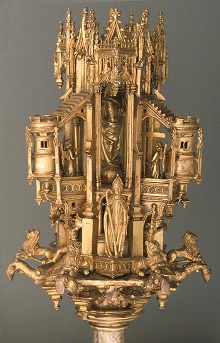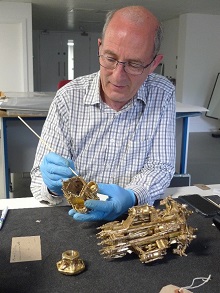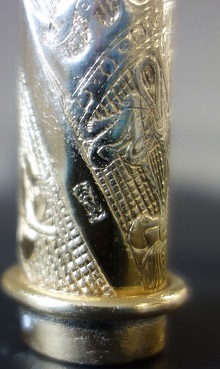For the first of our “From the Archive” series, we will be flashing back to 2017 when one of the most iconic objects from the University’s collections, The Mace of St Salvator’s College, underwent some conservation work at the University of Glasgow’s studio in Kelvinhall. Dr Helen Rawson, then Co-Director of Museum Collections, writes on the conservation process and the surprising discoveries that were revealed!
To view the mace, or explore more of our collection, click here to view the museums online catalogue!
The Maces of the University of St Andrews
The University’s maces represent its authority. The University has seven maces: three dating from the 15th century, and four from the modern period. The earliest, the Mace of the Faculty of Arts, was commissioned in 1416, just a few years after the University’s foundation. The most recent, the Six Centuries Mace, was made to celebrate the University’s 600th anniversary and completed in 2014.
The maces have been used in formal ceremonies, such as graduation, since their creation, and provide a direct connection to the experiences of past generations of students and staff.
The Mace of St Salvator’s College
The Mace of St Salvator’s College is the most spectacular of the maces. It was commissioned by the College founder, Bishop James Kennedy, and created in Paris in 1461 by the goldsmith Johne Maiel. It is made of silver, partly gilded, with an iron core.

Design
The mace head takes the form of an open shrine, containing at its centre the figure of St Salvator, Christ the Holy Saviour, on a globe representing the world. He bears the wounds of the crucifixion. Three angels carry three emblems of the Passion of Christ: the pillar, cross and spear. Below these are three dungeon entrances, each containing a chained wild man with shields representing the see of St Andrews, Bishop Kennedy and St Salvator’s College. The figures of a king, a bishop and possibly a merchant probably represent the Three Estates of medieval society.
The rod has three knops, consisting of an arrangement of pulpits and balconies. On the highest are three angels and three scholars with books. The lowest features three scholars or preachers with scrolls and three figures looking upwards towards the Saviour in adoration. The emphasis on the number three in the design relates to the Holy Trinity.
Conserving the Mace
The mace was conserved in June 2017, to ensure that it remains in the best possible condition, and can continue to be safely used in ceremonies. A specialist independent conservator, Richard Rogers, identified various issues, including a slight looseness, or wobble, to the head; a bent pinnacle on the mace-head; loose fixings for the angels on the highest knop on the rod; and tarnishing of the silver.

For the first time since 1866, the mace was dismantled. It was inspected and cleaned, while loose elements were stabilised and small repairs carried out. As the bent pinnacle on the mace-head was in danger of being lost, it was detached, straightened and carefully re-bonded: the weakness was found to result from a flaw in the original medieval casting. Throughout, the focus was on ‘conservation’, not ‘restoration’: respecting the historical integrity of the mace and the original craftsmanship, not making it appear as ‘good as new’.
The work was carried out in the University of Glasgow’s new conservation studios in Kelvinhall, generously made available for this purpose, instead of Richard Rogers’s usual lab in England. This enabled specialists from the University of St Andrews and National Museums Scotland to oversee the conservation and to take crucial decisions and make exciting discoveries as it progressed.

Discoveries
The conservation work provided invaluable insights into the original design and structure of the mace, and later repairs, through revealing the hidden interior. Previous work on the mace is known to have been carried out in 1685, by the goldsmith Michael Ziegler of Edinburgh, and in 1866, by the Edinburgh silversmiths G. and M. Crichton. Unfortunately, the exact nature of this work was not documented.
Dismantling the mace revealed how the various decorative elements are fixed together, and how the original structure has been altered in the past. Medieval wedges still hold fast after nearly six centuries, sometimes augmented by resin added later. The iron rod at the centre of the mace was found to have been adjusted, almost certainly in 1866, with the addition of screw turnings, securing the head and foot more firmly: precise measurements revealed these to be 5/8” Whitworth threads, a system devised in 1841 and in widespread use by the 1860s.
Close inspection of the angels on the top knop revealed that one appears to be medieval, one probably 17th century and one 19th century. This corresponds with the known dates of work on the mace and that missing angels had been replaced. Excitingly, a medieval maker’s mark was discovered on the mace rod.
Future Use
With the work complete, the Mace of St Salvator’s College will continue to be carried in ceremonies, as it has been for so many centuries. When not in use, this beautiful and powerful emblem of the University’s authority and history will be displayed in the Wardlaw Museum.